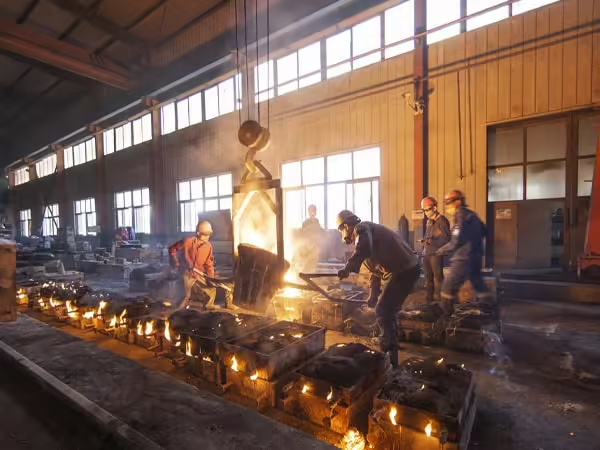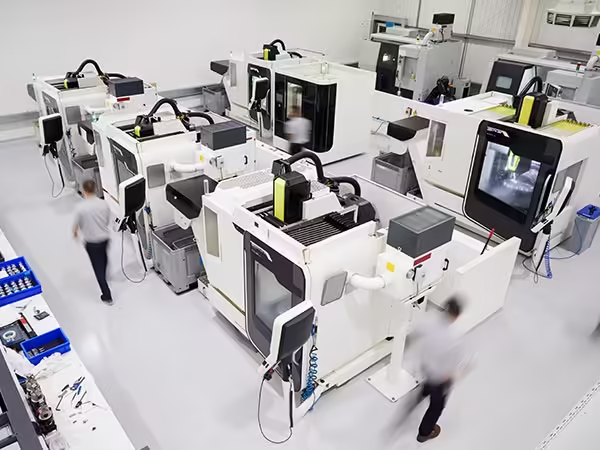8 starke Trends, die die Gießereiindustrie neu gestalten
Willkommen auf meinem Blog!
Ich freue mich sehr, dass du hier bist! Bevor wir uns in die Inhalte vertiefen, würde ich mich freuen, wenn du mir auf meinen Social-Media-Plattformen folgst. Dort teile ich zusätzliche Einblicke, vernetze mich mit unserer großartigen Community und halte dich über die neuesten Nachrichten auf dem Laufenden. So bleibst du in Verbindung:
📘 Facebook: Shanghai Leierwo Industriehandel Co., Ltd.
Lassen Sie uns gemeinsam auf diese Reise gehen! Ich hoffe, Sie finden die Inhalte hier nicht nur aufschlussreich, sondern auch inspirierend und wertvoll. Los geht‘s!
Inhaltsverzeichnis
Einführung

Der casting industry factory has long been a cornerstone of global manufacturing, providing essential components for automotive, aerospace, machinery, and construction sectors. However, the evolution of technology, environmental standards, and customer expectations has triggered significant changes across this industry. As global supply chains become more dynamic and competition intensifies, casting facilities must adapt swiftly to maintain operational efficiency and market relevance.
In this blog post, we will explore eight powerful trends currently reshaping the casting industry factory. From automation and digitalization to sustainability and workforce transformation, these developments are revolutionizing the way casting operations are managed and executed.
Trend 1: Automation and Robotics in the Fabrik der Gussindustrie
Automation has become an integral part of modern manufacturing, and the casting industry factory is no exception. Robotic systems are increasingly being deployed for tasks such as mold handling, pouring, and finishing operations. These technologies improve precision, reduce human error, and enhance workplace safety.
The adoption of programmable logic controllers (PLCs) and robotic arms has enabled casting factories to achieve consistent product quality and reduced cycle times. Moreover, these systems provide scalability, allowing operations to adjust to demand fluctuations without significant downtime or labor cost increases.
Trend 2: Digital Twin Technology and Smart Manufacturing
Another transformative trend in the casting industry factory is the rise of digital twin technology. A digital twin is a virtual replica of a physical system, enabling real-time monitoring and predictive analysis. By implementing digital twins, casting factories can simulate production scenarios, anticipate equipment failures, and optimize resource allocation.
Smart manufacturing, which integrates IoT sensors, data analytics, and cloud computing, further supports real-time decision-making. These advancements help casting facilities reduce waste, improve quality assurance, and respond rapidly to market changes.
Trend 3: Emphasis on Sustainability and Green Manufacturing

With the growing global focus on environmental protection, regulatory bodies worldwide are enforcing stricter guidelines on industrial emissions and resource consumption. The casting industry factory, known for its traditionally high energy use and environmental footprint, is now placing sustainability at the heart of its operational strategy. Manufacturers are investing heavily in energy-efficient machinery that reduces fuel consumption without compromising production capacity or product quality.
One key innovation is the adoption of advanced furnaces designed to utilize renewable energy sources, such as solar or biomass, or to operate with significantly lower fuel consumption. These cleaner energy options not only reduce greenhouse gas emissions but also decrease operational costs over time. Furthermore, casting factories are installing state-of-the-art water treatment facilities to recycle process water, minimizing water wastage and pollution.
Emission control technologies such as electrostatic precipitators, scrubbers, and catalytic converters are becoming standard in many casting factories, effectively reducing particulate matter, sulfur oxides, and nitrogen oxides released into the atmosphere. These sustainability initiatives not only help casting companies comply with increasingly stringent international regulations but also improve their reputation among environmentally conscious clients and partners.
In addition, green manufacturing practices extend to material sourcing and waste management. More factories are shifting toward recyclable raw materials and developing closed-loop systems to reclaim and reuse scrap metal. By integrating sustainability into every aspect of production, the casting industry factory is paving the way for a cleaner, more responsible future in manufacturing.
Trend 4: Advanced Materials and Alloy Innovations
Material science breakthroughs are revolutionizing the casting industry factory by introducing new alloys and composite materials that meet the ever-growing demands of modern engineering applications. Industries such as aerospace, automotive, and defense require components that offer superior mechanical properties while reducing weight and improving durability.
Cutting-edge alloy innovations feature enhanced strength-to-weight ratios, enabling lighter yet stronger parts. This is crucial in aerospace applications where every kilogram saved contributes to fuel efficiency and performance. Improved corrosion resistance ensures longer service life even in harsh environments, while enhanced thermal stability allows components to withstand extreme temperature variations without degradation.
Casting factories are now exploring the use of high-entropy alloys, metal matrix composites, and nano-reinforced materials to push the boundaries of conventional metal casting. These materials often reduce or eliminate the need for costly secondary processing, such as machining or heat treatment, as the cast parts achieve near-net shape and desired properties directly from the foundry.
The introduction of these advanced materials also encourages innovation in mold design and casting techniques, with factories adopting precision casting, investment casting, and vacuum-assisted methods to handle complex alloys. As a result, the casting industry factory is better equipped to serve high-performance sectors with demanding specifications, ultimately contributing to the development of next-generation products.
Trend 5: Workforce Reskilling and Talent Shortages
The integration of automation, digital tools, and smart manufacturing solutions is reshaping the skill requirements within the casting industry factory. While traditional casting skills remain foundational, the emergence of robotics, data analytics, and Industry 4.0 technologies demands a workforce capable of navigating these new environments.
Factories are responding by implementing comprehensive upskilling programs focused on digital literacy, equipment programming, process monitoring, and quality control. Partnerships with technical schools and vocational institutions are increasing to develop curricula aligned with industry needs, ensuring a pipeline of qualified talent.
Despite these efforts, talent shortages remain a critical challenge, especially in regions experiencing industrial decline or demographic shifts. The aging workforce in many casting factories adds urgency to recruitment and retention strategies. To attract younger generations, companies are enhancing workplace safety, offering flexible schedules, and providing competitive wages and benefits packages.
Moreover, fostering a culture of continuous learning and innovation is becoming a key differentiator. Casting industry factories that invest in employee development, promote cross-functional skills, and encourage innovation tend to experience higher productivity and employee satisfaction. Addressing workforce challenges is thus essential not only for operational success but also for maintaining a competitive edge in the evolving manufacturing landscape.
Mid-Article Table: Key Trends and Their Impacts on the Fabrik der Gussindustrie
| Trend | Impact on Casting Industry Factory |
|---|---|
| Automation & Robotics | Enhanced precision, reduced errors, improved safety |
| Digital Twin Technology | Predictive maintenance, better resource management |
| Sustainability Initiatives | Lower emissions, reduced energy consumption |
| Advanced Alloys & Materials | Improved part performance, reduced secondary processing |
| Workforce Reskilling | Higher operational efficiency, better talent retention |
| Additive Manufacturing Integration | Greater design flexibility, rapid prototyping |
| Global Supply Chain Diversification | Risk mitigation, improved lead times |
| Data-Driven Quality Control | Fewer defects, real-time inspection |
Trend 6: Integration of Additive Manufacturing
Additive manufacturing (AM), commonly known as 3D printing, is increasingly being adopted in the casting industry factory. While it doesn’t replace traditional casting, AM is used to create complex patterns, molds, and cores with unmatched precision and minimal material waste.
By integrating AM, factories can expedite prototyping, reduce tooling costs, and experiment with design modifications in a cost-effective manner. The synergy between casting and AM allows for greater innovation in product development.
Trend 7: Global Supply Chain Diversification

In the wake of geopolitical tensions and pandemic-induced disruptions, supply chain diversification has become a necessity. The casting industry factory is focusing on sourcing materials from multiple regions to avoid dependency on a single supplier.
Localized supply chains improve reliability and reduce lead times. Furthermore, reshoring strategies are being explored to bring critical casting operations closer to end-users, enhancing responsiveness and reducing transportation emissions.
Trend 8: Data-Driven Quality Control Systems
Modern casting factories are leveraging data analytics to improve quality control processes. Real-time inspection tools powered by machine learning and AI can detect defects at an early stage, reducing scrap rates and production downtime.
Automated systems collect and analyze data from each stage of production, providing insights that guide process improvements. These quality systems enhance customer satisfaction and support compliance with international standards.
Abschluss
Der casting industry factory is undergoing a remarkable transformation driven by technological innovation, environmental responsibility, and workforce evolution. As these eight powerful trends continue to influence operations, companies that embrace change and invest in future-ready practices will emerge as industry leaders.
From automation and smart technologies to sustainability and workforce development, the path forward is both challenging and full of opportunity. The casting factories of tomorrow will be agile, intelligent, and sustainable—ready to meet the demands of a rapidly changing world.
Häufig gestellte Fragen
What are the biggest challenges facing a casting industry factory today?
The primary challenges include adapting to new technologies, addressing environmental regulations, managing supply chain risks, and overcoming labor shortages.
How does automation benefit a casting industry factory?
Automation enhances precision, reduces manual labor, lowers operational costs, and improves workplace safety, all while ensuring consistent product quality.
Can traditional casting methods coexist with modern trends?
Yes, traditional casting techniques can coexist with modern innovations like digital twins and additive manufacturing, creating a hybrid model for efficiency.
What role does sustainability play in casting industry factory operations?
Sustainability is crucial for regulatory compliance, cost savings, and corporate responsibility. It helps reduce emissions, energy use, and material waste.
How important is workforce training in today’s casting industry?
Workforce training is vital to keep up with technological advancements and ensure that staff can operate new equipment and digital tools effectively.
Produktkategorien
- Ventilteile
- Wasserpumpenteile
- Lagergehäuseteile
- Druckgussteile
- Pumpenprodukte aus Edelstahl
- Pumpenprodukte aus Gusseisen
- Ventilteile für den Automobilgebrauch
- Autoteile
- Ventilteile für den zivilen Gebrauch
- Vakuumpumpenteile KF

